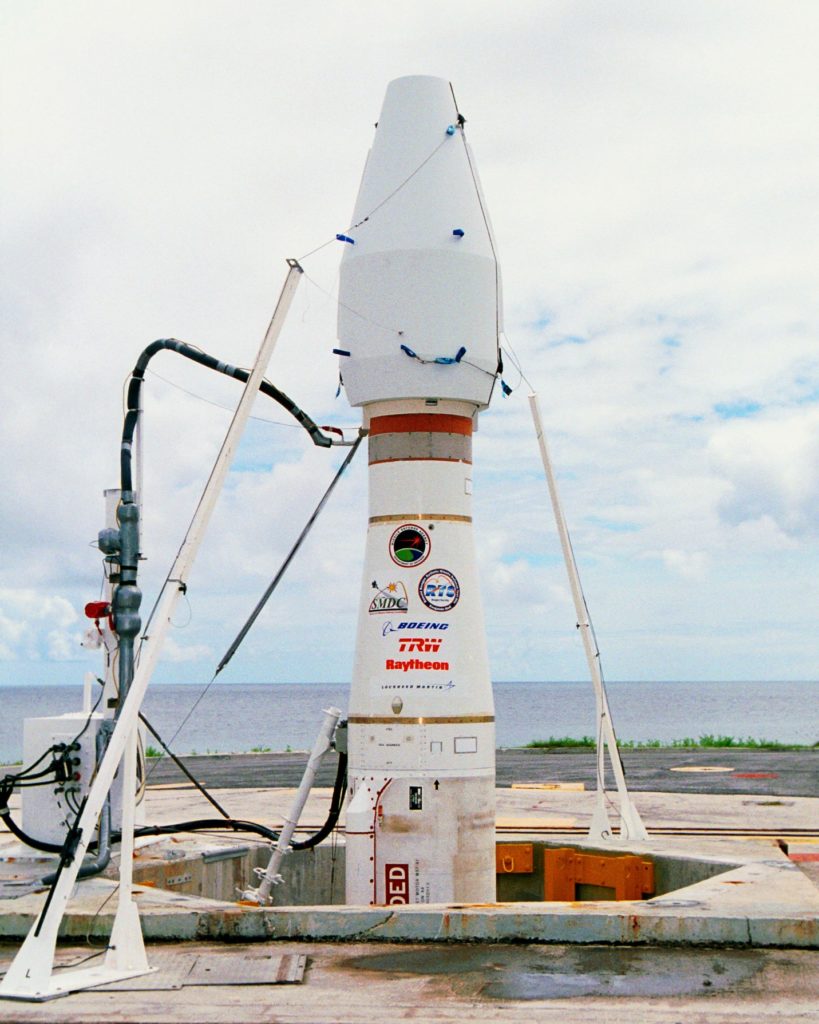A test of the Ground-based Interceptor (GBI) is scheduled for Thursday, January 28, sometime between 10 a.m. and 2 p.m. Pacific Standard Time.

GMD interceptor prior to launch. (Source: MDA)
Though it is not formally an intercept test, it will include a target missile launched from the Kwajalein Atoll in the Pacific. This will be an intermediate-range ballistic missile with some kind of countermeasures, including decoys. After the target is launched, a GBI, using a three-stage booster and a CE-II version of the kill vehicle, will be launched from Vandenberg Air Force Base in California toward the target. While it is possible the kill vehicle may attempt an intercept of the mock warhead, the test’s nominal goal is to observe the complex of objects and provide information about whether the kill vehicle can discriminate the target from decoys.
However, the primary goal of the test, according to the Director of the Missile Defense Agency (MDA), Vice Admiral James Syring, is to evaluate an improved “divert and attitude control system” (DACS), the part of the kill vehicle that steers it into the target. A failed intercept in December 2010 was eventually attributed to a failure of the DACS due to a “track gate anomaly.” This was the first failure directly attributed to this problem, but the issue was not new: The anomaly had been observed in eight tests over nine years, starting in 2001, and the MDA had attempted to compensate with numerous hardware and software fixes over the years. Thursday’s test is an attempt to validate a fix to the underlying problem of excessive vibration in the DACS.
This methodical approach seems a sensible way to incrementally improve the existinghardware. However, context is important here. Why is this problem just being fixed now?
The Missile Defense Agency began deploying interceptors equipped with the CE-II kill vehicle in October 2008 and continued through 2010. But it was not until July 2014—more than five and a half years after fielding began— that the CE-II kill vehicle successfully intercepted a target for the first time. The price tag for chasing down the track gate anomaly and fixing the CE-II kill vehicles that have already been produced was at last count nearly $2 billion.
Of the 30 GBIs currently in place in missile fields at Vandenberg and in Alaska, the majority use the CE-I version of the kill vehicle, which has had two successful intercept tests (though it failed its latest intercept test in 2013, which used a refurbished CE-I kill vehicle). The rest of the GBIs rely on the CE-II kill vehicle, which has just one successful intercept under its belt.
The Pentagon takes pains to distance its current approach to the Ground-based Missile Defense (GMD) system from the headlong rush to get something in the ground a decade ago to satisfy the Bush administration’s pledge to field an initial missile defense capability by 2004. However, while Director Syring does say he intends to follow a rigorous engineering process for missile defenses, it’s not clear he can actually do that under current constraints, which include a commitment by Secretary of Defense Hagel to field 14 more interceptors by 2017. In a response to a report by the Government Accountability Office last year, the MDA stated that it might delay putting the new interceptors in the field until at least one successful intercept test of the new CE-II kill vehicle design, but that they could not delay producing them until the new design had been tested because it would pose an unacceptable risk—not a risk that the interceptors wouldn’t work, but a risk that they would not be able to meet the 2017 deadline.
Whether Thursday’s test is a success or a failure, the larger picture is that the current approach to the GMD system is as different as it ought to be from its heritage of being fielded in a hurry and with little regard for rigorous engineering.
The strategy is still largely “do it right now,” not “do it right.”
